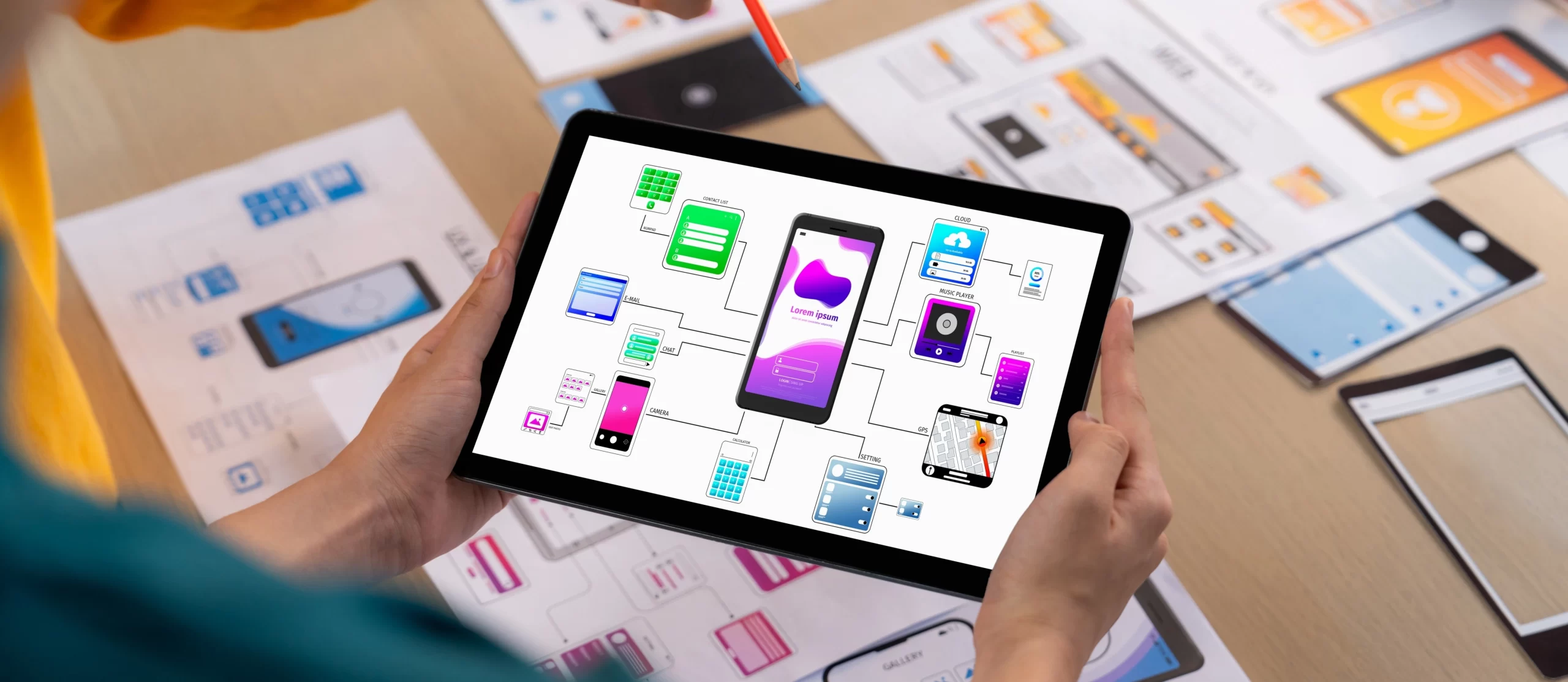A Business Guide to Native, Web, and Hybrid App Development
Author: Inza Khan
05 July, 2024
Businesses have various options to deliver software to their users amidst evolving software development trends. The choice often comes down to three types: native apps, web apps, and hybrid apps. Each has unique characteristics, advantages, and challenges, catering to different business needs and user preferences. Understanding these differences is important for making an informed decision that aligns with your business goals and technical capabilities. Let’s understand each type first:

Native Apps
Native apps are applications specifically designed and developed for a particular platform or device. These apps are built using programming languages and tools native to the platform, such as Swift or Objective-C for iOS and Kotlin or Java for Android.
Key Characteristics of Native Apps
Platform-Specific Development: Native apps are tailored for a specific platform, ensuring that they leverage the full range of functionalities and optimizations available on that platform.
High Performance: Due to their close integration with the operating system, native apps offer superior performance, responsiveness, and a seamless user experience.
Access to Device Features: Native apps can directly access and utilize device features such as GPS, camera, microphone, contacts, and biometric authentication, providing a richer user experience.
Enhanced User Experience: Native apps provide a consistent and intuitive user interface that adheres to the platform’s design guidelines, resulting in a familiar and engaging experience for users.
Challenges with Native Apps
Development Cost and Time: Developing native apps for multiple platforms can be costly and time-consuming as it requires separate codebases and specialized development teams for each platform.
Maintenance: Maintaining and updating native apps can be complex, especially when dealing with multiple platforms, as each update needs to be implemented separately.
Web Apps
Web apps are applications accessed through a web browser over the internet. They are not installed on the user’s device and can be used on any device with a compatible browser.
Key Characteristics of Web Apps
Cross-Platform Compatibility: Web apps are platform-independent and can run on any device with a web browser, making them accessible to a broader audience.
Ease of Deployment: Updates to web apps are instant and do not require users to download or install anything. The latest version is always available to all users.
Cost-Effective Development: Developing web apps is generally more cost-effective and faster compared to native apps, as they use a single codebase for all platforms.
Challenges with Web Apps
Limited Access to Device Features: Web apps cannot fully leverage the device’s native features, which can limit functionality compared to native apps.
Performance: Web apps may not perform as well as native apps, particularly in terms of speed and responsiveness, as they are dependent on the browser’s capabilities and internet connectivity.
User Experience: The user experience can be inconsistent across different browsers and devices, potentially leading to a less engaging interaction.
Hybrid Apps
Hybrid apps combine elements of both native and web apps. They are essentially web apps wrapped in a native container, allowing them to be installed on devices and distributed through app stores.
Key Characteristics of Hybrid Apps
Single Codebase: Hybrid apps use a single codebase for multiple platforms, typically written in web technologies like HTML, CSS, and JavaScript, which are then wrapped in a native shell.
Access to Native Features: The native shell allows hybrid apps to access device features, similar to native apps, providing a more integrated user experience than pure web apps.
Cost and Time Efficiency: Developing hybrid apps can be more cost-effective and faster than developing separate native apps for each platform, as they share a common codebase.
Challenges with Hybrid Apps
Performance: Hybrid apps may not match the performance and responsiveness of native apps, especially for complex applications requiring intensive processing or graphics.
User Experience: While hybrid apps strive to provide a native-like experience, there can be discrepancies and inconsistencies, particularly when compared to fully native apps.
Major Differences between Native vs. Web vs. Hybrid Apps
1- Usage and Accessibility
Web Apps:
Web apps are accessed directly through an internet browser, making them universally accessible on any device with internet connectivity. Users do not need to download or install anything. Examples include Google Docs and Gmail.
Native Apps:
Native apps can be installed on the device via app stores (e.g., Apple’s App Store or Google Play). Users can access them directly from the home screen. For instance, Instagram is a native app.
Hybrid Apps:
Hybrid apps can also be installed on the device like native apps but are essentially web apps wrapped in a native shell. Users can download them from app stores and access them directly. Twitter is an example of a hybrid app.
2- Internal Working and Development
Web Apps:
Web apps are developed using web technologies such as HTML, CSS, and JavaScript. They run client code in the browser and execute server-side logic on a web server.
Native Apps:
Native apps are built using platform-specific programming languages and tools (e.g., Swift or Objective-C for iOS, Java or Kotlin for Android). This allows them to fully leverage the platform’s capabilities.
Hybrid Apps:
Hybrid apps are developed using web technologies but wrapped in a native shell using frameworks like Ionic, Cordova, or React Native. This enables them to run on multiple platforms with a single codebase.
3- Access to Device Features
Web Apps:
Web apps have limited access to device features compared to native and hybrid apps. They might use browser-based APIs but cannot interact deeply with the hardware. For example, a web app can use the browser’s geolocation API but not access Bluetooth or NFC.
Native Apps:
Native apps have full access to all device features, enabling richer functionality. For instance, Google Maps can use GPS for location tracking and interact with other hardware components like the accelerometer.
Hybrid Apps:
Hybrid apps offer moderate access to device features through plugins and APIs. They can access functionalities like the camera or GPS but may not provide as comprehensive an experience as native apps.
4- User Experience
Web Apps:
The user experience of web apps can be inconsistent due to variations in browser capabilities. Features may look and function differently across various browsers and devices.
Native Apps:
Native apps provide a highly consistent user experience as they are designed to adhere to platform-specific design guidelines and user interface elements.
Hybrid Apps:
Hybrid apps offer a more consistent user experience than web apps but may still fall short of the seamless experience provided by native apps. They might not perform as smoothly in terms of animations and interactions.
5- Offline Capabilities
Web Apps:
Web apps are browser and network-dependent, meaning users need an active internet connection to use them. Offline capabilities are limited and rely on browser features like caching.
Native Apps:
Native apps offer one-step access with extensive offline capabilities. Once installed, they can function without an internet connection, making them reliable for offline use.
Hybrid Apps:
Hybrid apps provide offline capabilities similar to native apps. They can store data locally and function without an internet connection.
6- Performance
Web Apps:
Web apps tend to be slower and less responsive due to their reliance on internet connectivity and browser performance.
Native Apps:
Native apps are optimized for the specific platform they are built for, providing the best performance. They are faster, more responsive, and can handle complex tasks smoothly.
Hybrid Apps:
Hybrid apps often perform better than web apps but may not match the speed and responsiveness of native apps. They can also consume more battery power due to their reliance on web technologies.
7- Development Cost and Time
Web Apps:
Web apps are typically more cost-efficient and faster to develop as they use a single codebase that works across multiple platforms.
Native Apps:
Native apps are more expensive and time-consuming to develop because separate versions must be created for each platform, requiring expertise in different programming languages and tools.
Hybrid Apps:
Generally, hybrid apps have proven to be more cost-effective and faster to develop than creating separate native apps for each platform. A single codebase can be used across multiple platforms, reducing both development time and cost.
Which Type of App Should Your Business Choose?
When deciding between native, web, and hybrid apps, businesses should consider their specific needs, resources, and goals. Web apps are ideal for early-stage startups needing a quick, cost-effective solution. They are perfect for applications that require minimal interaction with device features and are used primarily for information dissemination or simple user interactions, such as Google Docs and Gmail.
Native apps, on the other hand, are best suited for applications requiring high performance, rich user experiences, and extensive use of device features. Companies with large, active user bases or complex app functionalities, such as gaming or banking apps, will benefit most from native app development, as seen with Instagram and PUBG Mobile.
Hybrid apps offer a good compromise between performance and cost, making them suitable for businesses that need to reach a broad audience across multiple platforms without the high costs and time investment of developing separate native apps. Examples include Twitter and Uber. By understanding the differences between these types of apps, businesses can make informed decisions about their app development strategies, optimizing their resources to deliver the best user experience.
Conclusion
When considering software development services for your business needs, Xorbix Technologies provides a comprehensive range of solutions tailored to meet various requirements. With expertise in native, web, and hybrid app development, Xorbix offers unparalleled performance and access to device features through native apps, making them ideal for businesses requiring complex functionalities. For startups or projects with budget constraints, Xorbix’s web app development services offer cost-effective solutions without compromising on quality or accessibility. Additionally, businesses looking for a balance between performance and cost can benefit from Xorbix’s expertise in hybrid app development, leveraging a single codebase across multiple platforms.
By partnering with Xorbix Technologies, businesses can make informed decisions about their app development strategies, optimizing resources to deliver a compelling user experience and achieve their business objectives effectively.




